
The longhorn beetles (Cerambycidae), also known as long-horned or longicorns, are a large family of beetles, with over 35,000 species described. Most species are characterized by extremely long antennae, which are often as long as or longer than the beetle's body. In various members of the family, however, the antennae are quite short and such species can be difficult to distinguish from related beetle families such as the Chrysomelidae. The scientific name of this beetle family goes back to a figure from Greek mythology: after an argument with nymphs, the shepherd Cerambus was transformed into a large beetle with horns.

Lamiinae, commonly called flat-faced longhorns, are a subfamily of the longhorn beetle family (Cerambycidae). The subfamily includes over 750 genera, rivaled in diversity within the family only by the subfamily Cerambycinae.
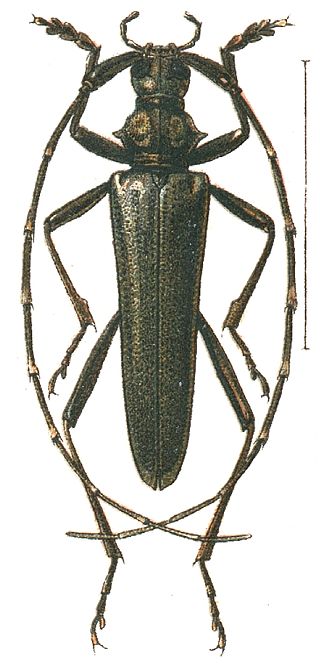
The Disteniidae are a small family of beetles in the superfamily Chrysomeloidea, traditionally treated as a group within the Cerambycidae.
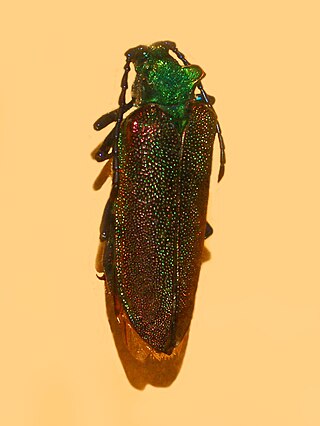
The Oxypeltidae are a small family belonging to the superfamily Chrysomeloidea, widespread in the Andean region of Chile and Argentina. They have traditionally been considered a group within the Cerambycidae.
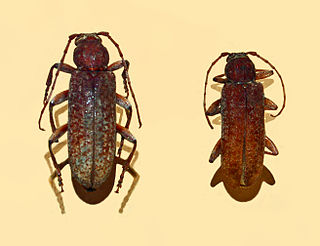
Cotyachryson philippii is a species of round-necked longhorns beetle belonging to the family Cerambycidae, subfamily Cerambycinae.

Bimiini is a tribe of beetles in the subfamily Cerambycinae, containing the following genera and species:

Bothriospila is a genus of beetles in the family Cerambycidae, and the type genus of the tribe Bothriospilini. It contains two species: the type, Bothriospila elegans, found in Brazil and Paraguay, and Bothriospila pulcherrima, found in Brazil. The latter was described as a new species from Brazil in 2012. Bothriospila was circumscribed in 1923 by Swedish entomologist Per Olof Christopher Aurivillius.
Ranqueles is a genus of beetles in the family Cerambycidae. The genus was circumscribed by French entomologist Pierre-Émile Gounelle in 1906, with the South American R. mus assigned as the type, and at that time, only species. It now contains the following species:
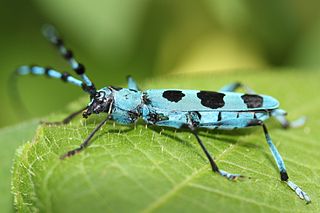
Compsocerini is a tribe of beetles in the subfamily Cerambycinae, containing the following genera:
Phantazoderus frenatus is a species of longhorn beetle in the Cerambycinae subfamily, and the only species in the genus Phantazoderus. The species was described by Léon Fairmaire and Jean-François Germain in 1864. It is known from Chile and southern Argentina. In flight, Phantazoderus frenatus is easily confused with species of Pyractomena, with which it shares coloration. Its rarity may be due to the density relationship with its model, as a remnant of Batesian mimicry.

Sybilla coemeterii is a species of longhorn beetle in the Cerambycinae subfamily. It was described by Thomson in 1856. It is known from Chile and central Argentina.
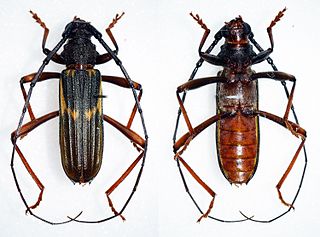
Chlorida denticulata is a species of beetle in the family Cerambycidae. It was described by Buquet in 1860. It's known distribution is in Guyana, French Guiana, and Ecuador. Known host plants include Eperua rubiginosa, Ormosia paraensis, Hevea guianensis.
Ranqueles gounellei is a species of beetle in the family Cerambycidae. It was described by Bosq in 1947. It is known from northern central Argentina and Bolivia. It feeds on Acacia aroma, Prosopis chilensis, and Prosopis juliflora.
Ranqueles mus is a species of beetle in the family Cerambycidae. It was described by Pierre-Émile Gounelle in 1906. It is known from central and northwestern Argentina. It feeds on Prosopis nigra.
Ranqueles steparius is a species of beetle in the family Cerambycidae. It was described by Osvaldo Rubén Di Iorio in 1996. It is found in Neuquén Province, Argentina.
Monnechroma subpulvereum is a species of beetle in the family Cerambycidae. It was described by Martin Schmidt in 1924, who named it Callichroma (Xenochroma) subpulvereum, designating it to be the type species of the subgenus Xenochroma, subsequently found to be an invalid. It is known from southeastern Brazil.
Aponoeme amazonica is a species of beetle in the family Cerambycidae. It was described by U. R. Martins in 1985. It is known from the state of Amazonas, Brazil.

Parasemnus is a genus of beetle in the family Cerambycidae, and contains the single species Parasemnus regalis. It is endemic to the central regions of Chile, and was first described in 1894 by Philbert Germain.

Xestoleptura crassicornis is a species of flower longhorn in the beetle family Cerambycidae. It is found in North America.

Pachylocerus is a genus of longhorn beetles in the subfamily Cerambycinae. Species in the genus are found only in the Oriental (Indo-Malayan) region.











